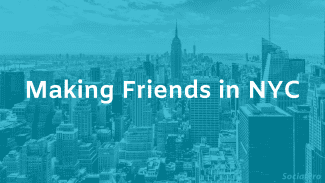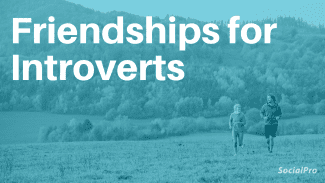There are a lot of people in the world, and as you go about your day-to-day life there’s a pretty good chance you’re going to meet some of them.
While many of the people you meet will remain acquaintances, some of them will become your friends.
The difference between a friend, acquaintance, close friend, and intimate friend
There are 4 stages of friendship – acquaintance, casual friend, close friend, and intimate friend:
- An acquaintance is a person you know, but who is not a close friend.[2] It’s the person you run into in the hallway or feel comfortable meeting in a group setting, but usually not by yourself.
- A casual friend is a person you are more emotionally attached to.[3] You feel comfortable meeting with this person one on one.
- A close friend is a person you spend time with regularly and can depend on. You feel comfortable reaching out to this person at any time.
- An intimate friend is someone you can share anything with.
One study found that the difference between friends and acquaintances is that we reveal much more of ourselves to a friend than an acquaintance, and we try harder to impress acquaintances than friends.[1]
Considering these two components can help you determine whether someone is your acquaintance or your true friend:
- How much do I trust this person/how comfortable am I sharing the more personal details of my life with them?
- How concerned am I with impressing this person/how comfortable am I being my true self around them?
Now let’s take a closer look at each of the different categories of friendship and how they play out on a day-to-day basis.
Level 1. Acquaintanceship
Acquaintances can be people you’ve just met as well as people you’ve known for a while. It isn’t necessarily the amount of time you’ve known a person that makes them an acquaintance (because it’s entirely possible to become close friends with someone very quickly).
A person is your acquaintance if you only see them coincidentally instead of making intentional plans to see each other. With an acquaintance, you will say “hello,” ask surface-level questions about life (work, the kids, the weather), and move on. Acquaintances are not people you discuss personal details or serious topics with.
An example of an acquaintance is the friend-of-a-friend who’s always present at your group hang-outs but who you never hang out with unless your mutual friend is also present. This is the person who is close friends with your close friend, but the two of you are not close friends with one another.
Another example is someone you regularly encounter at social events, and although you may have a brief conversation when you see each other, you never make plans to see each other on purpose.
Like we mentioned before, you may feel more of a need to impress your acquaintances than you do with your friends. When you are at this level of friendship with someone, they are still closer to “stranger” than “friend” and you are still trying to make a good impression.
If you don’t know someone very well, you’re probably not going to show up to hang out with them in your pajamas (like you would with a close friend). You’re also probably not going to share your deepest, darkest secrets with them– as an acquaintance, you simply aren’t at that level of closeness with one another and it would likely come across as needy.
Here’s an example using one of my real-life acquaintances:
I like to take my dogs to a local dog park when the weather is nice. I don’t go on the same days or at the same times, I just go whenever I get a chance and feel up to it.
There are many different people at the dog park, but I’ve encountered the same woman on more than one occasion and every time she’s there we end up talking. These conversations are always exclusively about our dogs, the military (since the dog park is on a military base), and events taking place in our city.
We don’t meet up on purpose, we don’t discuss the more personal details of our lives, and we don’t make plans to hang out in the future. But if we happen to run into each other again, that’s great. It would be rude not to speak with acquaintances when you see them, but it is not expected that you make plans to see them intentionally.
Read more about how to make friends here.
Level 2. Casual friendship
If, during the course of my conversation with this woman (let’s call her Joan), I decided that we had so many common interests or had such a good time talking that I’d like to invite her to bring her dog over to my house to play with my dogs, then we would be entering casual friendship.
A casual friend is different than an acquaintance because you make plans to see each other instead of just seeing each other in passing or by chance. However, with a casual friend, your hang-outs may be sporadic and are often related to the same type of event that took place when you met.
Remember how I invited Joan’s dog to come play with my dog? It makes sense because we met at the dog park and have dogs as a mutual interest. At this stage, I’m not going to plan regular dog play-dates or invite Joan’s family to come to dinner with my family.
A casual friend can be someone from work with whom you occasionally eat lunch or attend work-related conferences. You probably wouldn’t call on a casual friend to help you change a flat tire or pick you up at the airport.
Read more: How to find friends who are more like you.
Level 3. Close friendship
Now, if Joan and I were to occasionally hang out while our dogs played, and continue to see each other in passing at the dog park, we may discover that we both love Mexican food. We may decide to go get dinner one night, and while having dinner we may begin to open up more about the details of our jobs, our families, and our personal histories. We would then begin making intentional plans to spend time together more regularly.
At this point, Joan and I would be entering the stage of close friendship.
In a close friendship, you spend time together regularly and the things you do together do not revolve solely around the event where you first met. Just like Joan and I would begin to do things that don’t involve our dogs, a close friend is someone you would hang out with outside of work or school, doing non-work and school-related activities.
A close friend is someone who makes an effort to help when you need it and can be depended upon to keep their word.
In close friendships, you are comfortable discussing the things that go on in your day-to-day life, both good and bad. You share your secrets, commiserate with one another on the bad days, and celebrate with one another on the good days.
Level 4. Intimate friendship
The last and deepest level of friendship is the intimate friend. This is a best friend– the type of friend who knows everything about you and you about them. No matter how far apart you may ever live, the intimate friendship is one that lasts a lifetime.
In an intimate friendship, there are few topics that are ever off-limits. The intimate friend is one who can point out your flaws and offer suggestions for improvement, and while it may be difficult to hear, it isn’t offensive because you understand how deeply they care for you (and you’re willing to do the same for them).
The difference between a close friendship and an intimate friendship is primarily time. A close friendship that withstands the ups and downs of life over an extended period of time is considered an intimate friendship.
Check this out: How to make close friends.
From acquaintance to close friend
After reading through the descriptions of each type of friendship, you may have realized you have more acquaintances than you think. While it’s perfectly normal for your acquaintances to outnumber your close friends, what can you do if you’d like to turn some of those acquaintances into closer friends?
First, check out our guide on small talk and conversation topics. This guide will teach you how to begin with small talk and gradually work your way to a deeper conversation with someone. Moving from superficial small talk topics to more personal conversations (in a natural, comfortable way) is the first step in turning an acquaintance into a close friend.
Having a successful conversation with someone (that isn’t small talk) creates a natural opportunity for you to plan a time to hang out with them. Like we explained before, making plans to spend time with someone moves you from “acquaintance” to “casual friend.” Here’s an example of what you can say:
“I really enjoyed talking with you. We should [go see that movie we talked about/go shopping at that place you mentioned/hang out and play that game together/get coffee and talk more about that] sometime! Are you free _________?”
Once you’ve hung out with someone once, it’s important to continue planning to spend time together if you wish to develop a close friendship. Make sure that you aren’t pushy when you initiate hang-outs; your social outings don’t need to be back-to-back, and you don’t have to plan another time to hang out immediately after finishing your last hang-out. Ideally, the other person will also initiate some of your plans to spend time together– this is an important hallmark of a two-way friendship.
When you are hanging out together, continue having quality conversations as we teach you in this guide. The more you talk and find things in common, the more comfortable you will become around one another. As a result, you will begin to open up more to one another and your conversations will naturally become deeper and more personal. When this happens, you will find that your former acquaintance is now your close friend.
Can friendships go from friend back to acquaintance?
Now that you know about each type of friendship and what you can do to move from acquaintance to close friend with someone, you may be wondering if your friendships can move in the opposite direction.
The answer is yes.
Because your friendships progress when you begin spending more time with someone, it stands to reason that they will regress when you stop spending as much time with someone. While this is not always the case (like in long-distance friendships), the inability to spend time with a friend does present new challenges when it comes to remaining close.
So if you notice that someone seems a little more distant than normal, ask yourself how much time you’ve spent with them recently to help you determine whether this could be causing your friendship to move backward.
Friendships are a necessary part of your mental and emotional health, but it’s important to know who your real friends are.
In what category do most of your friendships fall? Share in the comments below!









How does one deal with a friendship which started off very comfortably and grew over time. However, she turned out to be very emotional and turned disrexpectful and rue and never explained why. Then after a lapse of a year or so she renewed the friendship and we had much in common and enjoyed social activities. Then suddenly she turned rude and insulting without any explanation. I concluded that this was not the kind of friendship I was looking for and gradually distanced myself from her. I was not comfortable with erratic behaviour and not being one myself that it was best to move on. I made the right decision and so relieved that I do not have to deal with her.
How would you reate my tits?
I have this guy friend that says we are just acquaintances but there’s not a day goes by that we don’t call each other and talk about everything. and then there is times I will go hang out and have coffee with him at his house. I tell him that we are friends, and he tells me no just acquaintances. What do you think??
A scenario for you. I know a man whom I consider a friend. We met in real time and have corresponded for two years. It is a platonic friendship because he lives in another country, but visits the US regularly. He speaks very little English and I’m just learning his language. We are on each others Facebook pages and talk on Viber regularly. One day, I saw a person write him a post that refer to me as his “acquaintance.” This was written in his language. I’m wondering if maybe there is maybe a translation difficulty here or whether should I be offended. Do you think this woman is trying to reduce me in his eyes because she may be jealous of our friendship?
Definitely need a word between acquaintance and friend to denote “casual friend”.
I know lots of people who are not what I would call friends, but who are most definitely much more than acquaintances.
I have no causal friends or superficial friends I don’t have time for that that kind of friendship is a waste of time
Exactly!!!
how do you go straight to close friendships without going through a casual friendship?
Good point it starts out that way but if it stays that way very long then I end the friendship they can consider themselves cut off I was casual friends with a guy he was in a serious relationship but he was also seriously a jerk I yelled at him a little bit because he was a bad friend
Thank you so much for this post! Would love to share this if it’s okay, too many people default to the word “friend” without acknowledging there really is a difference in relationships.
Ummm I’m Vanessa…so I’m asking David lol sorry about that
Thank you so much =) Feel free to share as long as you link back!
Most definitely will link back 🙂
Thank you!
What if you only hang out 2 times a year and ask them you wish to hang out more, they agree and want to hang out more but nothing happens, you talk on the phone once a month for 30-60 minutes (awkward pauses galore), text often but they only give you a few minutes, that person says a bunch of stuff like “I now have more time for people that matter to me”, or “I am looking for a small group of close friends rather then aquantances”, both right to your face like they are talking to you, you have both been through huge crisis together and been there for one another but everything feels so much like an aquantance. They also say for you to call anytime you want and they will always be up for talking to you, how much they really appreciate you and your friendship but my idea of friendship is you actually see eachother at least once a month, face to face is pretty important in a friendship especially post 30. I am a he, my friend is a she.
It sounds like your friendship may have moved from a close friendship back to some form of casual friendship. It sounds like neither of you can be completely honest with each other about your feelings and that one or both of you aren’t making it a priority to see each other anymore.
Am I allowed to share this information on my website for Aspergers adults? I will link back to this page for more information.
You’re more than welcome to Deanne, thank you for sharing it!